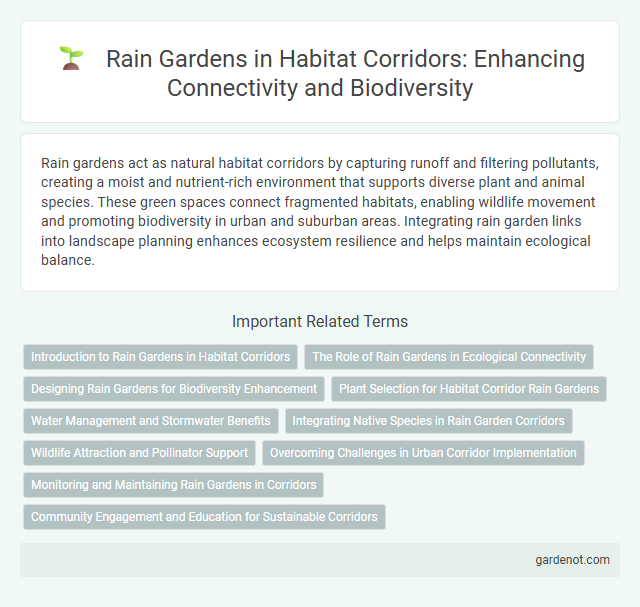Rain gardens act as natural habitat corridors by capturing runoff and filtering pollutants, creating a moist and nutrient-rich environment that supports diverse plant and animal species. These green spaces connect fragmented habitats, enabling wildlife movement and promoting biodiversity in urban and suburban areas. Integrating rain garden links into landscape planning enhances ecosystem resilience and helps maintain ecological balance.
Introduction to Rain Gardens in Habitat Corridors
Rain gardens play a critical role in habitat corridors by enhancing stormwater management and supporting native biodiversity. These shallow, vegetated basins filter pollutants from runoff, reduce erosion, and provide essential habitat for pollinators and amphibians. Integrating rain gardens within habitat corridors promotes ecological connectivity and resilience in urban and suburban landscapes.
The Role of Rain Gardens in Ecological Connectivity
Rain gardens serve as vital habitat corridors by filtering stormwater runoff and providing native vegetation that supports pollinators and wildlife species, enhancing ecological connectivity in urban environments. These green infrastructures create continuous green spaces that link fragmented habitats, facilitating species movement and genetic exchange. By improving water quality and offering refuges for amphibians, birds, and insects, rain gardens contribute significantly to the resilience and biodiversity of urban ecosystems.
Designing Rain Gardens for Biodiversity Enhancement
Rain garden design for biodiversity enhancement centers on selecting native plant species that provide habitat and food resources for local pollinators, birds, and beneficial insects. Incorporating a layered vegetation structure with deep-rooted perennials, shrubs, and groundcovers optimizes water filtration and supports diverse wildlife communities. Strategic placement within habitat corridors ensures connectivity, facilitating species movement and ecosystem resilience.
Plant Selection for Habitat Corridor Rain Gardens
Selecting native plants such as sedges, rushes, and wildflowers enhances the functionality of habitat corridor rain gardens by improving water filtration and providing essential food and shelter for local wildlife. Deep-rooted species like blue flag iris and swamp milkweed stabilize soil while promoting groundwater recharge within the corridor. Incorporating diverse plant layers supports pollinators and bird populations, fostering ecological connectivity along urban and rural landscapes.
Water Management and Stormwater Benefits
Rain garden links in habitat corridors improve water management by capturing and filtering stormwater runoff, reducing pollutants entering local waterways. These natural filtration systems enhance groundwater recharge and mitigate flood risks by slowing water flow and promoting infiltration. Effective stormwater benefits include decreased erosion, improved water quality, and support for diverse plant and animal species within the corridor.
Integrating Native Species in Rain Garden Corridors
Integrating native species in rain garden corridors enhances biodiversity by providing essential habitat and food sources for local wildlife, including pollinators and bird species. Native plants improve water filtration and soil stabilization, reducing runoff and promoting groundwater recharge within these habitat corridors. Selecting region-specific flora ensures ecological resilience and supports long-term sustainability in urban and suburban environments.
Wildlife Attraction and Pollinator Support
Rain garden links serve as vital habitat corridors by attracting diverse wildlife, including birds, amphibians, and beneficial insects. These gardens provide abundant nectar and pollen sources that support pollinators such as bees, butterflies, and hummingbirds, enhancing local biodiversity. Strategic planting with native flora maximizes habitat connectivity and bolsters ecosystem resilience in fragmented urban landscapes.
Overcoming Challenges in Urban Corridor Implementation
Rain garden links enhance urban habitat corridors by improving stormwater management and supporting native biodiversity. Designing these green infrastructure elements addresses challenges like limited space and soil contamination through innovative, site-specific solutions. Integrating rain gardens within urban corridors strengthens ecological connectivity while mitigating urban runoff and pollution.
Monitoring and Maintaining Rain Gardens in Corridors
Rain garden link plays a critical role in habitat corridors by improving water filtration and supporting biodiversity. Regular monitoring involves assessing soil moisture levels, plant health, and pollutant capture efficiency to ensure optimal performance. Maintaining rain gardens includes removing invasive species, replenishing native plants, and inspecting irrigation systems to sustain their ecological benefits within the corridor.
Community Engagement and Education for Sustainable Corridors
Rain garden link projects foster community engagement by involving local residents in planting and maintaining biodiverse habitats that improve water quality and support wildlife corridors. Educational programs within these initiatives promote awareness of sustainable landscaping practices and the ecological benefits of rain gardens, empowering communities to actively participate in habitat restoration. Collaborative workshops and citizen science opportunities enhance stewardship and reinforce the importance of interconnected green spaces for resilient urban ecosystems.
Rain garden link Infographic

 gardenot.com
gardenot.com